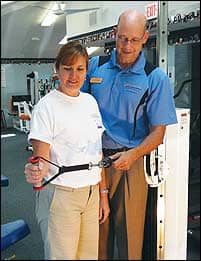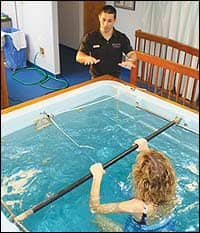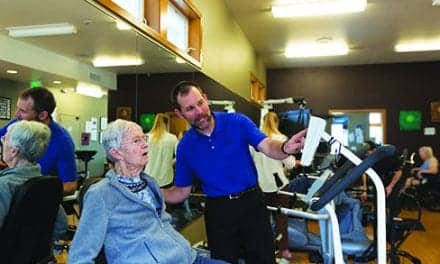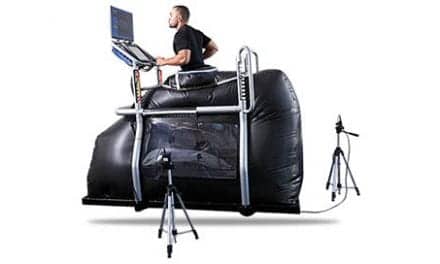How to keep functionally active for years to come.
 |
| The author, right, works with client Michelle Shoener, weekend warrior and tennis player, on an upper body strengthening routine. |
Waking up this morning, knees cracking as I walked down my wooden steps, I realized something. If my shoulders are painful now after playing racquetball, and my ankles are sore after running basketball on Tuesday nights, what the heck am I going to do when I am 60 years old and have to play catch with the grandkids? Although I am only 46 years old (and a physical therapist), I realize that if I keep going at my current pace, pushing my body through the 40- or 50-year warranty indicated on our performance index, I may not be able to “get up and go” by the time I am 60. My hope is to remain physically strong, mentally sharp, and functionally mobile well into the 8th and 9th decades of life, working hard to stay independent and relevant to the next generation of weekend warriors!
Many of Rehab Management’s readers most likely spent the last weekend playing ball, running, biking, or performing some type of physical activity to challenge their bodies to higher levels of performance. Despite the search for ways to remain active and healthy, the fact is, we are all getting older. (According to reports from the US Census Bureau, one in three individuals in the United States is older than age 40, while daily an estimated 7,918 Americans turn 60.)
Fortunately, the number of health clubs is significantly increasing—an estimated 23,400 nationwide—to meet the fitness needs of this aging demographic. Unfortunately, exercise- and exercise equipment-related injuries have sent more than 166,000 individuals in this age group to the emergency department.
A HEALTHY AND ADVENTUROUS FUTURE?
Back in the 1990s, futurist and author Faith Popcorn wrote about her assumptions regarding the future of society, citing several trends she thought would evolve over the next decade. Among the trends that Popcorn mentioned were:
- Awareness that good health extends longevity;
- Adventures whet our appetites for roads untaken; and
- People will belong to groups that represent common feelings, causes, or ideals.
Indeed, Popcorn’s theories are time-tested, by both the general population and weekend warriors. We have seen emerging trends of weekend sports leagues (basketball, baseball, hockey, and football) for adults who are trying to find better ways to take care of themselves and enjoy good health, while keeping it fun and adventurous, and working in groups or pods of those with common interests, such as bike clubs, workout groups, etc.
 |
| Robert Babb, PT, MBA |
Although increased activity is a positive factor in most lifestyles, the problem with aging weekend warriors is that, as they get older, their bones become less stable, muscles decrease in size, and tendons and ligaments become less elastic. These body changes pose an increased injury risk.
STOP MOVING, GROW OLD
Our bodies grow old because we stop moving. Regular bouts of exercise can help prevent adverse health effects and keep bodies in great shape, at any age (while keeping us primed and ready for the weekend). Whether in groups seeking adventure or an individual looking to extend their longevity, consulting a physical therapist to help create a training regimen will likely include:
Aerobic exercise: To strengthen heart and lungs, one of the best and easiest aerobic activities is walking. Special equipment is not necessary, and it can be done almost anywhere. To get aerobic benefit, walk briskly, or fast enough to increase your pulse and breathing, but not so fast that you can’t talk comfortably. You can also add up exercise time slowly, and even do this with walking groups. Walking 10 minutes three times a day is roughly equivalent to walking 30 minutes once a day. Want to get a treadmill? Great idea, just get outside on the sunny days to get your dose of vitamin D and enjoy the fresh air.
Muscle-strengthening and core-stabilization activities: Are a must to build muscles, improve posture, and burn fat. The key to core stabilization is learning to use the deep muscles of your trunk. Feel those muscles when you cough? That’s them. To contract them, imagine pulling your belly button back toward your spine. Hold this contraction for 5 to 10 seconds, and then relax. Other functional resistance exercises include:
|
Resistance tubes and bands: Believe it or not, exercise tubes and bands are not just for beginners. They come in varying resistances, some of which are downright challenging! They can be found at most sporting good centers, or visit your local physical therapist who will issue you a group of exercises designed to meet your warrior needs. Tubing exercises give resistance in a concentric fashion, which is where the muscle shortens. Think biceps curls. They also work (unlike free weights) eccentrically, where the muscle lengthens. This makes the exercise doubly effective.
Exercise balls: Exercise balls are economical and portable, making them a perfect piece of home equipment for the weekend warriors. They are also referred to as stability balls, fit balls, balance balls, and gym balls. Prices range from $10 to $40, depending on the quality. The higher-priced balls usually have a burst-resistant property. Working out on an exercise ball requires active deep core muscles. This makes them excellent for developing the balance needed for athletic performance enhancement.
All muscle groups can be challenged on the ball; abs, glutes, legs, and upper body. Resistance tubes can be used in conjunction with the ball for added challenge. Many people sit on a ball when they are working at their computer in order to promote better postural alignment. The balls are inflatable and deflatable, which means that you can take them along on vacation!
Dynamic pulley system: A dynamic pulley system set up on an inclined glide board. Exercises can be done from either the incline or decline position. The machines have varying levels of calibrated resistance, which represent a proportion of the user’s body weight, are done on three planes of movement, and generally use body weight as resistance.
Flexibility: Weekend warriors suffer from a marked decrease in flexibility over a period of years. This is a result of changes in the body’s connective tissue, combined with the development of arthritis. Lack of flexibility means that the knees, hips, and other joints must bear greater stress during exercise. This stress can gradually injure joints. To stay flexible, stretch all your major groups of muscles. These include the muscles of your arms, back, hips, and front and back of your thighs and calves. Try to stretch for 10 to 12 minutes a day, after a brief warm-up. Do some stretches first thing in the morning, take a stretch break instead of a coffee break, or stretch in the office for a few minutes. Or participate in activities that include stretching, such as dance, martial arts, Tai Chi, or yoga.
Tai Chi: A traditional Chinese mind-body relaxation exercise consisting of 108 intricate exercise sequences performed in a slow relaxed manner over a 30-minute period. Tai Chi, sometimes called Tai Chi Chuan, is a noncompetitive, self-paced system of gentle physical exercise and stretching. To do Tai Chi, you perform a series of postures or movements in a slow, graceful manner. Each posture flows into the next without pausing.
Anyone, regardless of age or physical ability, can practice Tai Chi. It doesn’t take physical prowess. Rather, Tai Chi emphasizes technique over strength.
COORDINATION AND AGILITY PROGRAMS
Bosu: The word “Bosu” stands for “both sides up.” Exercises can be performed with either the dome or platform side facing upwards. Basic theory exists on the more you challenge yourself to keep it stable, the more your mind remembers how to keep the limbs steady. This is valuable for the times you lose your balance, as any balance device will help make the right muscles fire at the right time to keep you upright!
Wii: An experience for the senses of balance and coordination, all while keeping it fun skiing or playing tennis, baseball, or other sports. This is a terrific balance routine for home.
FOR THE MIND AND BODY
A strong relationship has been established between mental and physical well-being. Both mental and physical agility can be enhanced by even the smallest of changes in one’s routine.
 |
| Physical therapist Jim Fagnani, DPT, CSCS, oversees runner Mary Higgins’ aquatic therapy session. |
As an example, climb stairs with the “other” leg, the less dominant one. Control your computer mouse with your “other” hand, challenging your nondominant hand. Even brush your teeth with your “other” hand, or stand up while you read or work. Stand on one foot while you’re doing the dishes, or walk 20 minutes from your house or office, taking as many turns as possible.
INJURY PREVENTION AND MANAGEMENT
Knowing when to rest: Getting the body ready to perform is a key factor for the weekend warrior. A regular exercise program needs to incorporate a variety of low intensity exercises preparing the warrior for their chosen sport. Giving the body rest is a key success factor in keeping these athletes performing for many years to come. Older athletes cannot train 7 days a week, but can exercise to optimize the foundations of a weekend warrior, including aerobic activity, strengthening, flexibility, coordination, and a sharp mind.
Periodization: Young athletes employ what’s called “periodization,” alternating workouts that are intense and light, long and short to prevent overtraining and burnout. This approach should be used with the weekend warriors, keeping themselves functionally active all week to prepare for their weekend activities.
Aquatic exercise: Unloading the joints, using the buoyancy properties of the water, helps support the joints with nourishment (synovial flushing of the joints provides nutrition), all while keeping the joints moving without the compression found on treadmills or walking in a mall. Consider aquatic exercise as a healthy alternative one or two times a week.
So, you want to stay in the game? Stay ahead of the aging process, keeping yourself injury free with a combination of exercises designed to let you enjoy your time with other weekend warriors!
Robert Babb, PT, MBA, is owner and operator of the Physical Therapy and Wellness Institute (PTW), Lansdale, Montgomeryville, and Quakertown, Pa. For more information, contact .






